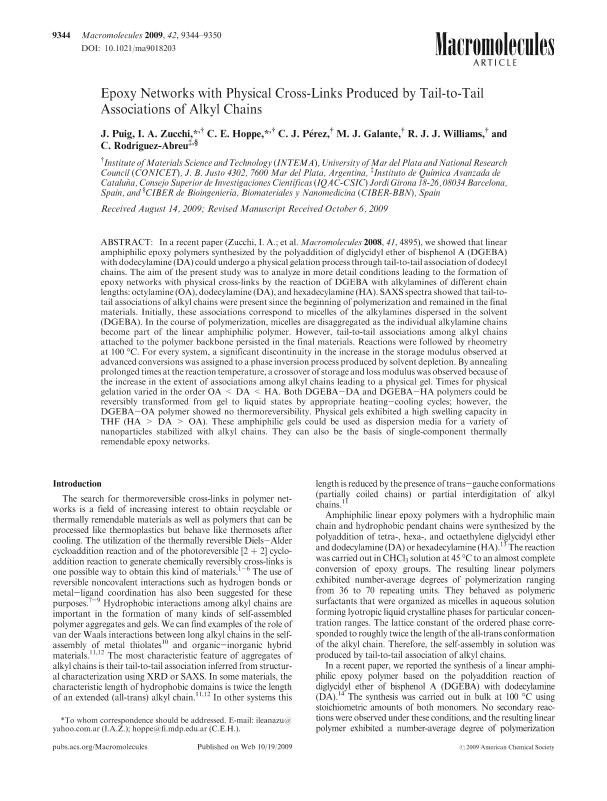Mostrar el registro sencillo del ítem
dc.contributor.author
Puig, Julieta

dc.contributor.author
Hoppe, Cristina Elena

dc.contributor.author
Pérez, Claudio Javier

dc.contributor.author
Galante, Maria Jose

dc.contributor.author
Williams, Roberto Juan Jose

dc.contributor.author
Rodríguez Abreu, C.
dc.date.available
2018-01-30T17:05:21Z
dc.date.issued
2009-10
dc.identifier.citation
Puig, Julieta; Hoppe, Cristina Elena; Pérez, Claudio Javier; Galante, Maria Jose; Williams, Roberto Juan Jose; et al.; Epoxy Networks with Physical Cross-Links Produced by Tail-to-Tail Associations of Alkyl Chains; American Chemical Society; Macromolecules; 42; 23; 10-2009; 9344-9350
dc.identifier.issn
0024-9297
dc.identifier.uri
http://hdl.handle.net/11336/35019
dc.description.abstract
In a recent paper (Zucchi, I. A.; et al. Macromolecules 2008, 41, 4895), we showed that linear amphiphilic epoxy polymers synthesized by the polyaddition of diglycidyl ether of bisphenol A (DGEBA) with dodecylamine (DA) could undergo a physical gelation process through tail-to-tail association of dodecyl chains. The aim of the present study was to analyze in more detail conditions leading to the formation of epoxy networks with physical cross-links by the reaction of DGEBA with alkylamines of different chain lengths: octylamine (OA), dodecylamine (DA), and hexadecylamine (HA). SAXS spectra showed that tail-to-tail associations of alkyl chains were present since the beginning of polymerization and remained in the final materials. Initially, these associations correspond to micelles of the alkylamines dispersed in the solvent (DGEBA). In the course of polymerization, micelles are disaggregated as the individual alkylamine chains become part of the linear amphiphilic polymer. However, tail-to-tail associations among alkyl chains attached to the polymer backbone persisted in the final materials. Reactions were followed by rheometry at 100 °C. For every system, a significant discontinuity in the increase in the storage modulus observed at advanced conversions was assigned to a phase inversion process produced by solvent depletion. By annealing prolonged times at the reaction temperature, a crossover of storage and loss modulus was observed because of the increase in the extent of associations among alkyl chains leading to a physical gel. Times for physical gelation varied in the order OA < DA < HA. Both DGEBA−DA and DGEBA−HA polymers could be reversibly transformed from gel to liquid states by appropriate heating−cooling cycles; however, the DGEBA−OA polymer showed no thermoreversibility. Physical gels exhibited a high swelling capacity in THF (HA > DA > OA). These amphiphilic gels could be used as dispersion media for a variety of nanoparticles stabilized with alkyl chains. They can also be the basis of single-component thermally remendable epoxy networks.
dc.format
application/pdf
dc.language.iso
eng
dc.publisher
American Chemical Society

dc.rights
info:eu-repo/semantics/openAccess
dc.rights.uri
https://creativecommons.org/licenses/by-nc-sa/2.5/ar/
dc.subject
Epoxy Networks
dc.subject
Physical Crosslinks
dc.subject
Reversible Networks
dc.subject.classification
Recubrimientos y Películas

dc.subject.classification
Ingeniería de los Materiales

dc.subject.classification
INGENIERÍAS Y TECNOLOGÍAS

dc.title
Epoxy Networks with Physical Cross-Links Produced by Tail-to-Tail Associations of Alkyl Chains
dc.type
info:eu-repo/semantics/article
dc.type
info:ar-repo/semantics/artículo
dc.type
info:eu-repo/semantics/publishedVersion
dc.date.updated
2018-01-25T19:53:48Z
dc.journal.volume
42
dc.journal.number
23
dc.journal.pagination
9344-9350
dc.journal.pais
Estados Unidos

dc.journal.ciudad
Washington, USA
dc.description.fil
Fil: Puig, Julieta. Consejo Nacional de Investigaciones Científicas y Técnicas. Centro Científico Tecnológico Conicet - Mar del Plata. Instituto de Investigaciones en Ciencia y Tecnología de Materiales. Universidad Nacional de Mar del Plata. Facultad de Ingeniería. Instituto de Investigaciones en Ciencia y Tecnología de Materiales; Argentina
dc.description.fil
Fil: Hoppe, Cristina Elena. Consejo Nacional de Investigaciones Científicas y Técnicas. Centro Científico Tecnológico Conicet - Mar del Plata. Instituto de Investigaciones en Ciencia y Tecnología de Materiales. Universidad Nacional de Mar del Plata. Facultad de Ingeniería. Instituto de Investigaciones en Ciencia y Tecnología de Materiales; Argentina
dc.description.fil
Fil: Pérez, Claudio Javier. Consejo Nacional de Investigaciones Científicas y Técnicas. Centro Científico Tecnológico Conicet - Mar del Plata. Instituto de Investigaciones en Ciencia y Tecnología de Materiales. Universidad Nacional de Mar del Plata. Facultad de Ingeniería. Instituto de Investigaciones en Ciencia y Tecnología de Materiales; Argentina
dc.description.fil
Fil: Galante, Maria Jose. Consejo Nacional de Investigaciones Científicas y Técnicas. Centro Científico Tecnológico Conicet - Mar del Plata. Instituto de Investigaciones en Ciencia y Tecnología de Materiales. Universidad Nacional de Mar del Plata. Facultad de Ingeniería. Instituto de Investigaciones en Ciencia y Tecnología de Materiales; Argentina
dc.description.fil
Fil: Williams, Roberto Juan Jose. Consejo Nacional de Investigaciones Científicas y Técnicas. Centro Científico Tecnológico Conicet - Mar del Plata. Instituto de Investigaciones en Ciencia y Tecnología de Materiales. Universidad Nacional de Mar del Plata. Facultad de Ingeniería. Instituto de Investigaciones en Ciencia y Tecnología de Materiales; Argentina
dc.description.fil
Fil: Rodríguez Abreu, C.. Instituto de Química Avanzada de Cataluña. Barcelona; España. CIBER de Bioingeniería, Biomateriales y Nanomedicina; España
dc.journal.title
Macromolecules

dc.relation.alternativeid
info:eu-repo/semantics/altIdentifier/doi/http://dx.doi.org/10.1021/ma9018203
dc.relation.alternativeid
info:eu-repo/semantics/altIdentifier/url/http://pubs.acs.org/doi/abs/10.1021/ma9018203
Archivos asociados
